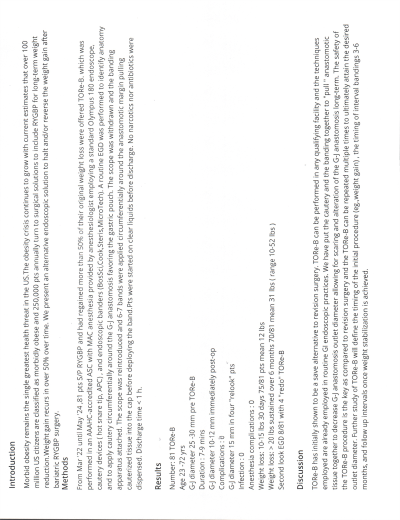Tuesday Poster Session
Category: Obesity
P4887 - TORe-B: An Endoscopic Alternative to Revision Surgery for Morbidly Obese Patients Whom Regained Weight After RYGBP
Tuesday, October 29, 2024
10:30 AM - 4:00 PM ET
Location: Exhibit Hall E

Has Audio

Allen Blosser
GCV
Herndon, VA
Presenting Author(s)
Richard Blosser, 1, Carolina Sawley, 2, Andrew VanDam, BA1, Angel Salfeld, MA1
1GCV, Reston, VA; 2AMGI, Reston, VA
Introduction: Morbid obesity remains the single greatest health threat in the US.The obesity crisis continues to grow with current estimates that over 100 million US citizens are classified as morbidly obese and 250,000 pts annually turn to surgical solutions to include RYGBP for long-term weight reduction.Weight gain recurs in over 50% over time. We present an alternative endoscopic solution to halt and/or reverse the weight gain after bariatric RYGBP surgery.
Methods: From Mar '22 until May '24 ,81 pts S/P RYGBP and had regained more than 50% of their original weight loss were offered TORe-B. which was performed in an AAAHC-accredited ASC with MAC anesthesia provided by anesthesiologist employing a standard Olympus 180 endoscope, cautery devices ( hot snare tip, APC) , and endoscopic banders (BosSci,Cook,Steris,MicroTech). A routine EGD was performed to identify anatomy and to apply cautery circumferentially around the G-J anastomosis favoring the gastric pouch. The scope was withdrawn and the banding apparatus attached. The scope was reintroduced and 6-7 bands were applied circumferentially around the anastomotic margin pulling cauterized tissue into the cap before deploying the band.Pts were started on clear liquids before discharge. No narcotics nor antibiotics were dispensed. Discharge time < 1 h.
Results: Number: 81 TORe-B
Age 23 -72 yrs
G-J diameter 25 -30 mm pre TORe-B
Duration : 7-9 mins
G-J diameter 10-12 mm immediately post-op
Complications : 0
G-J diameter 15 mm in four "relook" pts
Infection : 0
Anesthesia complications : 0
Weight loss: 10-15 lbs 30 days 75/81 pts mean 12 lbs
Weight loss: > 20 lbs sustained over 6 months 70/81 mean 31 lbs ( range 10-52 lbs )
Second look EGD 8/81 with 4 "redo" TORe-B
Discussion: TORe-B has initially shown to be a save alternative to revision surgery. TORe-B can be performed in any qualifying facility and the techniques employed are already employed in routine GI endoscopic practices. We have put the cautery and the banding together to "pull " anastomotic tissue together to decrease G-J anastomosis outlet diameter allowing for scaring and alteration of the G-J anastomosis long-term. The safety of the TORe-B procedure is the key as compared to revision surgery and the TORe-B can be repeated multiple times to ultimately attain the desired outlet diameter. Further study of TORe-B will define the timing of the initial procedure (eg.,weight gain) , the timing of interval bandings 3-6 months, and follow up intervals once weight stabilization is achieved.
Disclosures:
Richard Blosser, 1, Carolina Sawley, 2, Andrew VanDam, BA1, Angel Salfeld, MA1. P4887 - TORe-B: An Endoscopic Alternative to Revision Surgery for Morbidly Obese Patients Whom Regained Weight After RYGBP, ACG 2024 Annual Scientific Meeting Abstracts. Philadelphia, PA: American College of Gastroenterology.
1GCV, Reston, VA; 2AMGI, Reston, VA
Introduction: Morbid obesity remains the single greatest health threat in the US.The obesity crisis continues to grow with current estimates that over 100 million US citizens are classified as morbidly obese and 250,000 pts annually turn to surgical solutions to include RYGBP for long-term weight reduction.Weight gain recurs in over 50% over time. We present an alternative endoscopic solution to halt and/or reverse the weight gain after bariatric RYGBP surgery.
Methods: From Mar '22 until May '24 ,81 pts S/P RYGBP and had regained more than 50% of their original weight loss were offered TORe-B. which was performed in an AAAHC-accredited ASC with MAC anesthesia provided by anesthesiologist employing a standard Olympus 180 endoscope, cautery devices ( hot snare tip, APC) , and endoscopic banders (BosSci,Cook,Steris,MicroTech). A routine EGD was performed to identify anatomy and to apply cautery circumferentially around the G-J anastomosis favoring the gastric pouch. The scope was withdrawn and the banding apparatus attached. The scope was reintroduced and 6-7 bands were applied circumferentially around the anastomotic margin pulling cauterized tissue into the cap before deploying the band.Pts were started on clear liquids before discharge. No narcotics nor antibiotics were dispensed. Discharge time < 1 h.
Results: Number: 81 TORe-B
Age 23 -72 yrs
G-J diameter 25 -30 mm pre TORe-B
Duration : 7-9 mins
G-J diameter 10-12 mm immediately post-op
Complications : 0
G-J diameter 15 mm in four "relook" pts
Infection : 0
Anesthesia complications : 0
Weight loss: 10-15 lbs 30 days 75/81 pts mean 12 lbs
Weight loss: > 20 lbs sustained over 6 months 70/81 mean 31 lbs ( range 10-52 lbs )
Second look EGD 8/81 with 4 "redo" TORe-B
Discussion: TORe-B has initially shown to be a save alternative to revision surgery. TORe-B can be performed in any qualifying facility and the techniques employed are already employed in routine GI endoscopic practices. We have put the cautery and the banding together to "pull " anastomotic tissue together to decrease G-J anastomosis outlet diameter allowing for scaring and alteration of the G-J anastomosis long-term. The safety of the TORe-B procedure is the key as compared to revision surgery and the TORe-B can be repeated multiple times to ultimately attain the desired outlet diameter. Further study of TORe-B will define the timing of the initial procedure (eg.,weight gain) , the timing of interval bandings 3-6 months, and follow up intervals once weight stabilization is achieved.
Disclosures:
Richard Blosser indicated no relevant financial relationships.
Carolina Sawley indicated no relevant financial relationships.
Andrew VanDam indicated no relevant financial relationships.
Angel Salfeld indicated no relevant financial relationships.
Richard Blosser, 1, Carolina Sawley, 2, Andrew VanDam, BA1, Angel Salfeld, MA1. P4887 - TORe-B: An Endoscopic Alternative to Revision Surgery for Morbidly Obese Patients Whom Regained Weight After RYGBP, ACG 2024 Annual Scientific Meeting Abstracts. Philadelphia, PA: American College of Gastroenterology.
